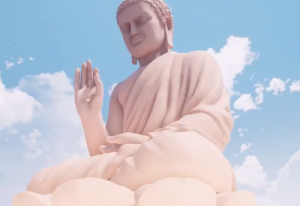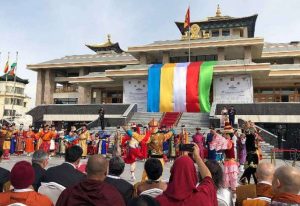
Published in 2016, Matthew J. Moore’s Buddhism & Political Theory is already approaching its first 10-year anniversary. Although not a new book, it remains one of enduring importance. Given the increasing political turbulence in the world and the still under-researched topic of Buddhist political theory, this work deserves more attention.
At a mere 208 pages (including back matter), Buddhism & Political Theory is a brisk and digestible read. Indeed, Moore shows restraint in his prose that is uncommon in academia. He admirably resists the temptation, often succumbed to by scholars, to produce the most turgid of purple prose to artificially inflate the length of their work. On the contrary, Moore is extremely terse in his writing, wasting no time on waffle yet without lapsing into ellipticism.
Buddhism & Political Theory is comprised of two parts, which Moore presents as “Buddhism’s Theory of Government” and “A Buddhist Political Theory” respectively. The former is principally a descriptive reconstruction of what the Buddhist tradition has to say about what the best political institutions are under historically contingent circumstances, while the latter sets forth the normative principles underpinning the former. The symmetry of the book is further compounded by each of the sections making three central points. In the first section, on Buddhism’s theory of government, three chapters depict three successive phases of the Buddhist theory of government.
The first is that of the Pali Canon, which clearly and definitively makes the case for “absolute monarchy” over republicanism. The ideal polity would be an anarchy comprised entirely of enlightened beings, but this not being a realistic possibility, the next best alternative—and the form of government most discussed by the Buddha—is rule by a cakkavatti (Skt: chakravartin, a universal monarch) subordinate only to the Buddha. Monarchy is given a dual justification. On the one hand it is the product of a primordial social contract depicted in the Agganna Sutta, although kingship is subsequently held in hereditary perpetuity. The second justification is by way of the king’s moral merit. Through his adherence to the Dharma, he brings about benefit for the kingdom and so justifies his power.
The second chapter concerns secondary texts of the Buddhist tradition. Interestingly, although the previous chapter was confined to the Pali Canon, here Moore treats texts from the Theravada, Mahayana, and Vajrayana traditions. The essential argument here is that while the traditions are unanimous in essentially affirming the theory found in the Pali Canon, the writers of this tradition went further by collapsing the division between the sacral and profane realms that Moore claims is to be found in the canonical texts. According to Moore, these later texts divinize the figure of the king both by casting him as a bodhisattva that chose to be born as a royal for the benefit of the masses, and by linking the bloodlines of the primordial first king of the Agganna Sutta and Shakyamuni Buddha.
The third chapter of the first section makes the case that with the advent of modernity, all Buddhist polities, which had for centuries (and in some cases millennia) had a principled preference for monarchy, came to be republican. Moore confines himself those states where Buddhism had been an integral part of the justification for monarchy. In practice, this means that his discussion excludes the Mahayana majority countries of East Asia, where the monarchy was justified primarily in Confucian and not Buddhist terms. In his examination of the Theravada and Vajrayana states, he finds that all opted for republicanism over the course of the period from the late 1800s to the early 21st century. What’s more, this choice was justified in explicitly Buddhist terms. Although Moore does not comment on it, this choice flies in the face of his own reading of the Pali Canon and its strong preference for monarchy. Finally, he finds that there was no one reason for this change of orientation. In some cases, it was driven by principle, in others by a contingent and pragmatic response to the forces of Western colonialism, and in still others the cause is indeterminate.
The arguments presented in the second half of the book, “A Buddhist Political Theory,” are much easier to concisely summarize. Firstly, Moore argues that Buddhism puts forth a theory of “limited citizenship.” This theory holds that, while some measure of political involvement is unavoidable and may even bring about some good, politics is in the main a waste of time on activities that could be spent more productively, for example in the pursuit of enlightenment.
Secondly, Moore makes the argument that the Buddha does not offer a prescriptive code of moral commandments, but rather a pragmatic set of advice that may be heeded or ignored, although one would be foolish to choose the latter course of action. This, Moore claims, may serve as a good basis for morality in the pluralistic societies of modernity.
Thirdly, Moore argues that Buddhism rejects any metaphysical or substantial concept of the self, accepting only a phenomenal concept of the self (that is, the individuated experience of being a self). This, he proposes, undermines the reality of the notion of the human individual and thereby challenges the liberal tradition dominant in the West, which centers the individual and their supposed inalienable rights.
The arguments in Moore’s book are not only plainly and articulately presented, but also in a compelling and forceful manner. His case for monarchy is daringly counter-cultural in the modern world where, as he recognizes, republicanism is almost totally hegemonic. His argument for limited citizenship is also brave, perhaps now even more than when it was written, in this age where political activism is treated as a substitute for personal virtue. This applies not only to the secular world, but to the Buddhist sangha. Buddhist readers of Moore’s book may call to mind the excesses that may result from a preoccupation with “social engagement” at the expense of the pursuit of enlightenment.
Buddhism & Political Theory should be regarded as the first, but certainly not the last, word in the English-language scholarly study of Buddhist political thought. Many of the arguments and lines of inquiry presented are open-ended invitations to further consideration, such that reading the book often feels like walking down a hallway full of newly opened doors to unexplored rooms.
Speaking generally, the problem lies in Moore’s stopping short of closing the gap between the first and second parts of the book. If Buddhist political theory is supposed to be the principles that undergird the Buddhist theory of government, the connection between the two is less than evident.
For example, the connection between monarchy and limited citizenship would seem to be an easy one to make. If engaging in politics is, for the most part, a distraction from spiritual pursuits, then it makes sense to concentrate government in a few hands to liberate the mass of people from having to be more than minimally concerned with it. Traditional monarchy, as opposed to modern totalitarianism, seems consonant with the “deflationary” account of politics advanced by Moore. Traditional monarchies did not engage in the kind of mass-mobilization campaigns we see in modern communist or fascist regimes. But Moore never explicitly makes this connection.
The connection between the other principles of Buddhist political theory identified by Moore and the Buddhist theory of government are even more opaque. Moore’s claim that anatta (Skt: anatman) has political implications rests on the notion that the doctrine decenters the individual from political discourse. But what, if anything, does the Dharma say about what should stand in its stead? Where does this leave notions such as human rights, which rest on the kind of ontological individualism that Moore says Buddhism rejects? Does the rejection of the liberal frame imply some kind of collectivism or communitarianism? Similarly, he makes no explicit statements about how Buddhist ethics are to be related to the organisation of government.
Perhaps the problem lies in Moore’s somewhat idiosyncratic definition of the “political.” Moore understands by “political” anything that relates to human life lived collectively. This, to my mind, would better be called social than political. His discussion of ethics and to a lesser extent anatta could then better be understood as a social theory than as a political theory, at least as they currently stand. But this is not to say these could not be further elaborated into a fully-fledged political theory.
A bigger problem with Buddhism & Political Theory is its clear and strong bias in favor of the Theravada tradition. Moore states that he only draws on the Pali Canon as these suttas are accepted as authentic by all Buddhist traditions, which is a perfectly legitimate point. But it is strange that he then goes on to discuss Mahayana and Vajrayana secondary literature. What is more, this discussion feels somewhat perfunctory, and puzzlingly leaves out important relevant texts such as On Why Monks Do Not Bow Down Before Kings by Lushan Huiyuan from the Chinese Mahayana tradition or The Just King by Jamgon Mipham from the Vajrayana.
Furthermore, some of Moore’s argument’s run into trouble precisely because he ignores these other traditions. For example, in his discussion of anatta in Chapter 4, Moore asserts that only a tiny number of Buddhists maintain that the doctrine of anatta teaches not that there is no self whatsoever, but merely that nothing within the phenomenal world can be identified as self. This is the position that interprets anatta as meaning “not-self” rather than “no self.”
It is true that this is an extremely marginal position, if one confines oneself to discussing Theravada. It is not, however, true of Buddhism as a whole. The large and highly influential set of sutras in the Mahayana tradition known as the Tathagatagarbha Sutras repeatedly and explicitly affirm that Nirvana has the quality of Mahatman or “Great Self.” Nowhere does Moore acknowledge this.
Moore’s arguments may have therefore been better served had he confined himself to discussing the Pali-Theravada tradition exclusively. It would be exceedingly interesting to see what political theorising could be developed from the Mahayana and Vajrayana, and how this may expand beyond or even contradict what Moore has presented.
Criticisms notwithstanding, Moore’s Buddhism & Political Theory is a well-written, engaging, and important book. It is well worth reading by both students of political theory and followers of the Buddhadharma. One certainly hopes that it will inspire more research and writing about Buddhist political theory.
References
Moore, Matthew J. 2016. Buddhism & Political Theory. Oxford: Oxford University Press.
Related features from BDG
“Us Versus Them:” Buddhist Perspectives on Navigating Disagreement and Division
Dharma and Politics
Related news reports from BDG
IBC Celebrates International Abhidhamma Day in New Delhi
India Recognizes Pali as a Classical Language, Highlighting Its Cultural and Religious Significance












